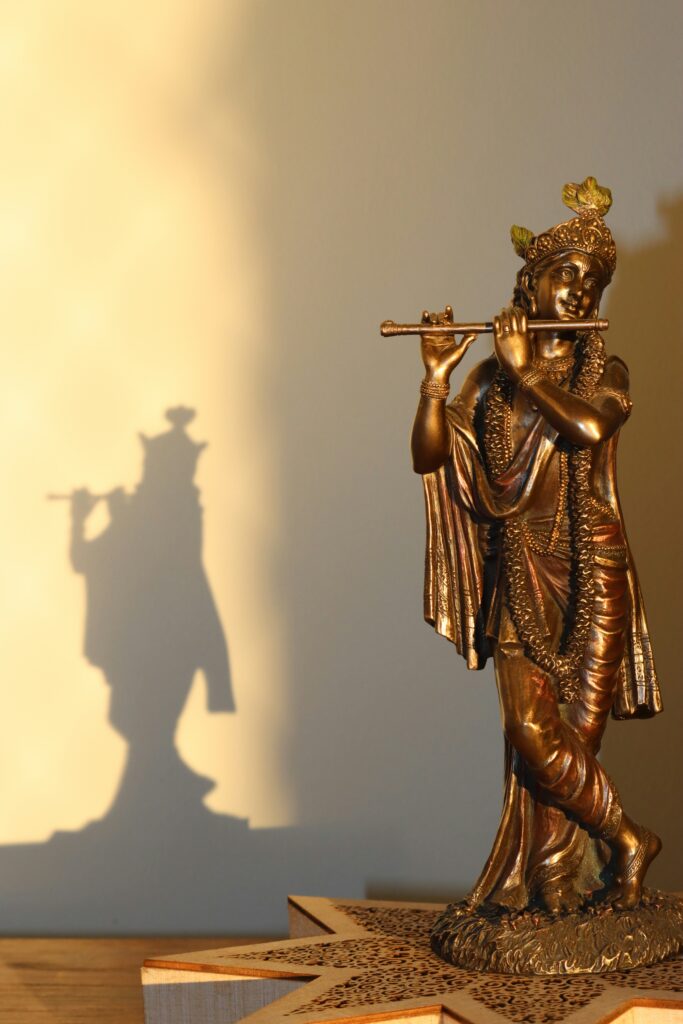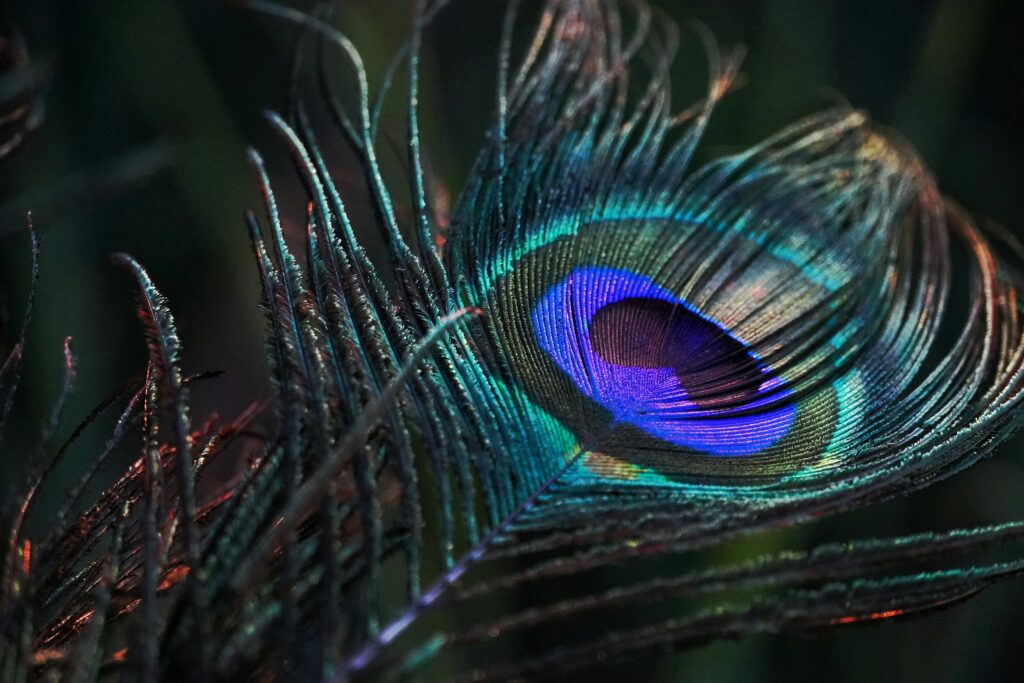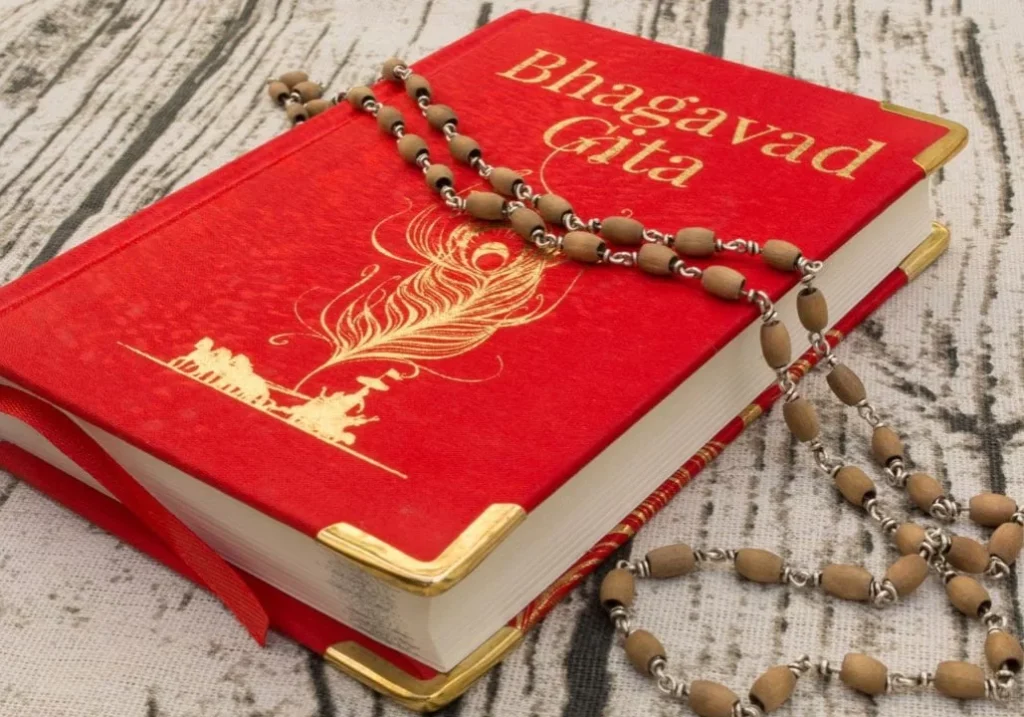Festivals
Celebrating the Birth of Lord Krishna: Krishna Janmashtami 2025

Who is Lord Krishna?
Hinduism embraces the belief in many gods and goddesses, each representing different aspects of the divine. Among the most revered are the Hindu Trinity, or Trimurti – three principal deities who govern the cosmic functions of creation, preservation and destruction. These three deities are Brahma (The Creator), Vishnu (The Preserver) and Shiva (The Destroyer and Transformer). Together, these three deities represent the cycle of creation, preservation and destruction – a fundamental concept in Hindu philosophy.

Since the role of Lord Vishnu is to protect and preserve, he is fully responsible for maintaining balance and order in the universe. Therefore, whenever evil, chaos or injustice rises, he takes on a human or diving form- known as an avatar- to restore righteousness and protect the good. Lord Vishu is believed to have total 10 principal avatars:
- Matsya (the fish), the first avatar of Lord Vishnu, who is believed to have saved Manu, the first man, from the great flood and preserved the seed of life.
- Kurma (the tortoise), the second incarnation of Lord Vishnu who played a central role during the Samundra Manthan (the churning of the cosmic Ocean of Milk to obtain “Amrita”, the nectar of immortality), by providing a support to Mount Mandara which was used as a churning rod. It’s this support that allowed the churning to continue, ultimately leading to the creation of the “Amrita” and other valuable items from the ocean.
- Varaha (the boar), the third avatar of Lord Vishnu, who is believed to have rescued the Earth from the depths of the cosmic ocean after it was dragged there by the demon Hiranyaksha.
- Narasimha (the half-man and half-lion), the fourth incarnation of Lord Vishnu, who is believed to have protected his devotee Prahlada and slayed his father, the tyrannical demon king Hiranyakashipu.
- Vamana (the dwarf), the fifth avatar of Lord Vishnu, who is believed to have humbled the powerful demon king Bali by asking for three paces of land.
- Parashurama (the warrior with an axe), the sixth incarnation of Lord Vishnu, who is believed to be a destroyer of evil on Earth and the liberator of Mother Earth from felons, ill-behaved men, extremists, demons and those blind with pride. He is also believed to be one of the immortals (Chiranjivi), destined to appear at the end of Kali Yuga to guide Lord Vishnu’s tenth and the last avatar, Kalki.
- Rama (the Maryada Purushottama – the ideal man), is the seventh avatar of Lord Vishnu, who is believed to have taken the human form to defeat Ravana (a powerful but tragic figure whose greatness was overshadowed by his ego and attachment) and restore righteousness (dharma) on Earth. As a first-born child of King Dashrath and Queen Kaushalya, he is also the prince of Ayodhya, and a protagonist of Ramayana – a classic tale of the triumph of good over evil.
- Krishna, is the eighth avatar of Lord Vishnu, who is believed to have taken human form to restore righteousness (dharma) and guide humanity. The protagonist of Bhagavad Gita – a Hindu holy scripture that presents a dialogue between Lord Krishna and the warrior Arjun on the battlefield of Kurukshetra.
- Buddha (the enlightened one), the ninth avatar of Lord Vishnu is a founder of Buddhism, a major religion in the world.
- Kalki, the tenth and the final incarnation of Lord Vishnu that is prophesied to appear at the end of Kali Yuga, and restore righteousness and usher in a new era of purity, the Satya Yuga again.
Lord Vishnu, incarnated as Lord Krishna, was the eighth son of Devaki and Vasudeva. He was born on the eighth day (Astami) of the dark fortnight of the month of Bhadra in the jail cell of his maternal uncle, Kansa. Kansa was a tyrannical King of Vrishni Kingdom with its capital at Mathura.
In his childhood, Lord Krishna is depicted as a very playful and mischievous child who loved stealing butter, which even earned him a nickname “Makhan Chor” meaning butter thief.

His youth is often depicted as a young man playing flute, surrounded by gopinis (milkmaids), especially Radha, his eternal consort. As he grew older, he became a powerful statesman and warrior, who played a central role in Mahabharata as a charioteer and spiritual guide to Arjuna on the battlefield of Kurukshetra.
Bhagavad Gita, one of the most important scripture in Hindu philosophy, is based on his teaching during this battle, in which he teaches about Dharma (duty), Karma (action without attachment), Bhakti (devotion) and the immortality of soul to Arjuna. These teachings are still studied and followed around the world.
Thus, Lord Krishna is the protector of Dharma (righteousness), the embodiment of love, wisdom and joy and a supreme being in many Vaishnavite traditions. He is also a cultural icon who appears in art, music, literature, dance and philosophy across centuries. Also known by his other names, Govinda (protector of cows), Gopal (the cowherd boy), Madhav (sweet like honey), Murlidhar (the flute bearer), Shyam (the dark-complexioned one) and Parthasarathy (charioteer of Partha-(Arjuna), Lord Krishna, this eighth incarnation of Lord Vishnu, is one of the most revered and beloved deities in Hinduism.
Why were Lord Krishna’s parents, Devaki and Vasudeva, imprisoned by Kansa?
Devaki and Vasudeva were imprisoned by Kansa because of a divine prophecy that foretold his death at the hands of their eighth child. Upon hearing the ominous prophecy from a celestial voice on their marriage, he grew fearful for his life. In desperation to prevent the prophecy from coming true, he even killed their first six children and kept them imprisoned under tight control, hoping to thwart fate. However, to protect Krishan from harm, his father Vasudev secretly took him across the Yamuna River to Gokul, where he was raised by Yashoda and Nanda. Thus, despite all efforts of Kansa, the diving plan unfolded with the birth of Lord Krishna, the eighth child, who eventually brought about the downfall of Kansa.
What is Krishna Janmastami and when is it celebrated?
Krishna Janmastami, also popularly known as Gokulashtami, is a major Hindu festival that marks the birth of Lord Krishna, the eighth incarnation of Lord Vishnu. Every year this festival is observed on the eighth day (Astami) of the Krishna Paksha (also known as the dark fortnight) in the month of Bhadrapada or Bhado- the sixth month in Hindu calendar, which typically falls between August and September in the Gregorian calendar. This festival is celebrated at midnight because as per the Hindu mythology, Lord Krishna was born at midnight.
When is Krishna Janmastami celebrated in 2025?
Krishna Janmastami in 2025 will be celebrated on August 16, which is Saturday. The Ashtami Tithi (the eighth lunar day) begins at 11:49 PM on August 15 and ends at 9:34 PM on August 16. The Nishita Puja (midnight worship) falls between 12:04 AM AND 12:47 AM on the night of August 16, which is considered the most auspicious moment.
How is Krishna Janmastami celebrated?
Devotees of Lord Krishna across the world celebrate this festival in different ways. However, the most common ones are fasting and devotional singing in which the devotees observe fasting without water (nirjala brata) until midnight, sing devotional songs (bhajans) and chant mantras related to Lord Krishna. Devotees also place the idols of baby Krishna in a decorated cradle and gently rock it to recreate his birth scene, which is commonly known as Jhulan Yatra (Swing Festival). In some parts of India, Dahi Handi is a very popular tradition, in which young men form human pyramids to break a pot filled with curd or butter, symbolizing Krishna’s love for butter. Similarly, dramatic plays and dances, commonly known as Rasa Lila, that depict scenes from Krishna’s lire are performed by children devotees. Also, the temples of Lord Krishna around the world are cleaned, lit and decorated and the devotees offer offerings to the deity. Nevertheless, at some places, this festival is also celebrated by reading Bhagavad Gita.

Who follows Krishna’s Teachings and the Bhagavad Gita?
Lord Krishna’s teachings through the Bhagavad Gita are followed and respected by millions of people across all cultures, not just as a religious scripture, but also as a universal guide to living a meaningful and conscious life.
Thus, Lord Krishna’s teachings are followed by Hindus – especially those who follow Vaishnavism (a tradition that worships Lord Vishnu and his incarnations). They view Krishna as the supreme god and the teacher of timeless truth about life, duty and the soul.
Lord Krishna’s teaching is also followed by the followers of ISKCON (International Society of Krishna Consciousness), which was founded by A. C. Bhaktivedanta Swami Prabhupada in 1966. Iskon followers worship Lord Krishna, chant his holy names and live by the teachings of the Bhadavad Gita as well as Bhagavata Purana. ISKCON temples that exist across the world also promote Krishna consciousness through devotion, singing and spiritual education.
Moreover, many non-Hindus, including yogis, philosophers and spiritual seekers also follow Bhadvad Gita and the teachings of Lord Krishna for its deep insight into Karma (action), Dharma (duty), detachment, meditation, and self-realization.
Nevertheless, Yoga practitioners who are into the classical path of yogas such as Jnana Yoga (path of knowledge), Karma Yoga (path of selfless action) and Bhakti Yoga (path of devotion) also follow the teachings of Lord Krishna by studying Gita as a practical manual for spiritual living.
Who are the famous people inspired by Bhagavad Gita and the teachings of Lord Krishna?
Bhagavad Gita and the teachings of Lord Krishna have inspired many famous thinkers, leaders, scientists and philosophers. Below is the list of most well-known personalities who admire or were influenced by the Gita’s teachings:

- Mahatma Gandhi from India called Gita his “spiritual dictionary” and practiced the Gita’s teaching on selfless action and non-attachment throughout his life and political work.
- A British writer and Philosopher, Aldous Huxley called Gita the “most systematic spiritual statement of the Perennial Philosophy” and highly admired its teachings on detachment, inner peace and the unity of all life.
- The former President of India and a renowned philosopher, Dr. Sarvepalli Radhakrishnan, has written extensive commentaries on the Gita, calling it “a universal scripture that transcends religion” and also emphasized that it teaches selfless living, wisdom and devotion.
- The American Philosopher and transcendentalist , Henry David Thoreau is also said to have found deep spiritual nourishment in the Gita and thus had kept a copy with him during his retreat at Walden Pond.
- Swami Vivekananda, a Hindu monk, philosopher, author, religious teacher and the chief disciple of the Indian mystic Ramakrishna is said to have received spiritual strength and purpose from Gita, especially during hard times and focused on the Karma Yoga aspect, which is performing one’s duties without attachment to results.
- An American theoretical physicist, J. Robert Oppenheimer, who is also known as the father of the atomic bomb, was influenced by the philosophical views of Gita on destruction, duty and cosmic order and also quoted Gita upon witnessing the first atomic bomb test in 1945.
- Winner of the Nobel Prize in Literature, a poet, essayist and playwright, Thomas Stearns Eliot is also said to have been influenced by Gita’s teachings on detachment and spiritual renewal.
- The Gita, along with ISKON is also believed to have shaped the spiritual path of George Harrison, a member of the English rock band, The Beatles. His song “My Sweet Lord” was also inspired by his devotion to Krishna.
Where are the major temples of Lord Krishna Located and what are the Key features of these temples dedicated to Lord Krishna?
Since Lord Krishna is believed to have been born and spent his life in India, the majority of the important temples dedicated to Lord Krishna are in India. These temples are important pilgrimage sites and attract millions of devotees every year.
Major Krishna Temples in India:
| Temples | Location | Key Features |
| Shri Krishna Janmabhoomi | Mathura | Birthplace of Lord Krishna |
| Dwarkadihish Temple | Dwarka | Krishna’s Royal City |
| Banke Bihari Temple | Vrindavan | Playful child form of Krishna |
| Jagannath Temple | Puri | Form of Krishna with siblings |
| Guruvayur Temple | Kerela | South India’s spiritual hub |
| Udupi Krishna Temple | Karnataka | Founded by Madhvacharya |
| Sri Sri Radha Madhava Mandir | Mayapur | The upcoming temple of the Vedic Planetarium that aims to be the largest Vedic temple in the world. |
Major Krishna Temples run by the International Society for Krishna Consciousness (ISKCON) are:
| Temples | Location and Key Features |
| ISKCON Vrindavan | Uttar Pradesh |
| ISKCON Delhi | East of Kailash, New Delhi |
| ISKCON Mayapur | West Bengal- which is also a global headquarter |
| ISKCON Bangalore | Karnataka- one of the largest Krishna temples in the world |
Some major temples dedicated to Lord Krishna are also outside India. They are:
| Temples | Location | Key Features |
| Bhaktivedanta Manor | Watford, UK | A major center for Krishna worship in the Uk, which was gifted by George Harrison of the Beatles to ISKCON. |
| Radha Krishna Temple | Utah, USA | Famous for its beautiful design and for hosting Holi Festival |
| ISKCON Los Angeles | USA | Also popular as New Dwarka temple |
| Sri Sri Radha Krishna Temple | Durban, South Africa | One of the largest Krishan Temples in the southern hemisphere. |
Moreover, in Nepal the most popular temples dedicated to Lord Krishna are:
- Krishna Mandir- Patan Durbar Square, Lalitpur, an ancient temple built by King Siddhi Narsingh Malla in the 17th century. Built entirely of stone in Shikhara style (rare in Nepal), with 21 golden pinnacles, this temple is the most famous Krishna temple in Nepal. The temple houses Lord Krishna with Radha and Rukmini. The beautiful carvings depict the scenes from the Mahabharata and Ramayana.
- Shree Krishna Pranami Mandir, Kathmandu, located in various locations in Nepal, mainly in Kathmandu and Bhaktapur, the devotees here follow the Krishna Pranami tradition, a devotional movement that reveres Lord Krishna as the supreme deity and focus on spiritual teachings and community service along with devotion to Krishna.
- ISKCON Nepal-Buddhanilkantha, Kathmandu, located at the base of Shivapuri Hill near Buddhanilkantha, this is the temple of the International Society for Krishna Consciousness. The temple houses deities like Sri Sri Radha Govinda and hosts major festivals like Janmastami, Gaura Purnima and Rath Yatra.
Krishna Janmastami will be followed by another big festival in Nepal, Kushe Aunsi, also known as Father’s Day. This Aunsi (new moon day) will be celebrated on 23rd of August 2025.






